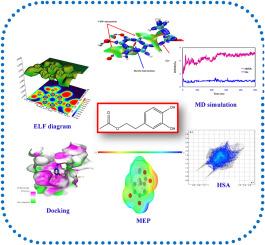Antioxidant efficacy of hydroxytyrosol, tyrosol, homovanillic alcohol, and their acetate derivatives in Parkinson's disease: A synergistic computational approach
IF 6.3
2区 医学
Q1 BIOLOGY
引用次数: 0
Abstract
Phenolic plant metabolites, including hydroxytyrosol, tyrosol, homovanillic alcohol, and their acetate derivatives, have emerged as potent antioxidants and promising therapeutic candidates for neurodegenerative disorders. These compounds exhibit dual functionality by efficiently scavenging reactive free radicals and targeting key protein residues, thereby alleviating oxidative stress and preventing cellular damage. Using multiscale in silico methodologies, their interactions with peroxyl (ROO•) and hydroperoxyl (HOO•) radicals, as well as with Monoamine Oxidase A (MAO-A), a pivotal enzyme in Parkinson's disease, were systematically investigated. Density Functional Theory (DFT) analyses illustrate radical stabilization pathways, supported by MEP, SD, NBO, FMO, and Fukui function descriptors. Hirshfeld surface analysis (HSA) and QTAIM further reveal strong binding hotspots, predominantly stabilized by conventional hydrogen bonding complemented with hydrophobic non-covalent contacts. ADMET profiling underscored favorable pharmacokinetic properties and drug-likeness. Finally, molecular docking and molecular dynamics (MD) simulations confirmed their stable accommodation within the MAO-A catalytic pocket, highlighting significant binding affinities and critical interacting residues. Overall, these findings establish hydroxytyrosol, tyrosol and homovanillic alcohol derivatives as potential multifunctional neuroprotective agents against Parkinson's disease.

羟基酪醇、酪醇、同型香草醇及其乙酸酯衍生物在帕金森病中的抗氧化功效:一种协同计算方法
酚类植物代谢物,包括羟基酪醇、酪醇、同型香草醇及其乙酸衍生物,已成为神经退行性疾病的有效抗氧化剂和有希望的治疗候选者。这些化合物具有双重功能,通过有效清除活性自由基和靶向关键蛋白残基,从而减轻氧化应激和防止细胞损伤。利用多尺度计算机方法,系统地研究了它们与过氧基(ROO•)和氢过氧基(HOO•)自由基以及与单胺氧化酶A (MAO-A)的相互作用,单胺氧化酶A是帕金森病的关键酶。密度泛函理论(DFT)分析了由MEP、SD、NBO、FMO和Fukui函数描述符支持的自由基稳定途径。Hirshfeld表面分析(HSA)和QTAIM进一步揭示了强结合热点,主要由常规氢键和疏水非共价接触来稳定。ADMET分析强调了有利的药代动力学性质和药物相似性。最后,分子对接和分子动力学(MD)模拟证实了它们在MAO-A催化口袋内的稳定安置,突出了显著的结合亲和力和关键的相互作用残基。总的来说,这些发现确立了羟基酪醇、酪醇和同型香草醇衍生物作为潜在的抗帕金森病多功能神经保护剂。
本文章由计算机程序翻译,如有差异,请以英文原文为准。
求助全文
约1分钟内获得全文
求助全文
来源期刊

Computers in biology and medicine
工程技术-工程:生物医学
CiteScore
11.70
自引率
10.40%
发文量
1086
审稿时长
74 days
期刊介绍:
Computers in Biology and Medicine is an international forum for sharing groundbreaking advancements in the use of computers in bioscience and medicine. This journal serves as a medium for communicating essential research, instruction, ideas, and information regarding the rapidly evolving field of computer applications in these domains. By encouraging the exchange of knowledge, we aim to facilitate progress and innovation in the utilization of computers in biology and medicine.
 求助内容:
求助内容: 应助结果提醒方式:
应助结果提醒方式:


